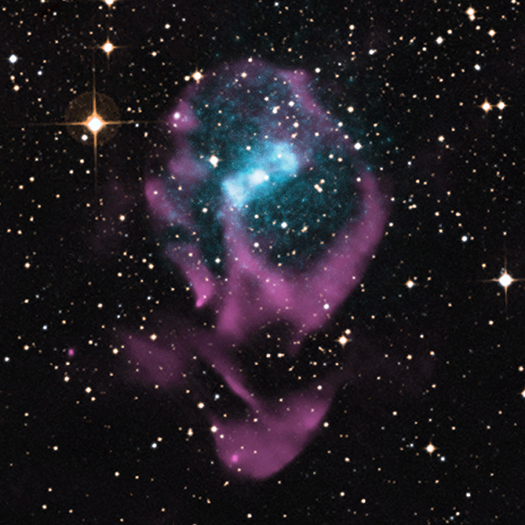For Release: December 04, 2013
NASA

Credit: X-ray: NASA/CXC/Univ. of Wisconsin-Madison/S.Heinz et al; Optical: DSS; Radio: CSIRO/ATNF/ATCA
Press Image and Caption
Data from NASA's Chandra X-ray Observatory has revealed faint remnants of a supernova explosion and helped researchers determine Circinus X-1 -- an X-ray binary -- is the youngest of this class of astronomical objects found to date.
As the name suggests, X-ray binaries are star systems made up of two parts: a compact stellar remnant -- either a neutron star or a black hole; and a companion star -- a normal star like our sun. As they orbit one another, the neutron star or black hole pulls in gas from the companion star. This heats the gas to millions of degrees, producing intense X-ray radiation and making these star systems some of the brightest X-ray sources in the sky.
Sebastian Heinz and his team at the University of Wisconsin-Madison (UW) discovered Circinus X-1 is less than 4,600 years old, making it the youngest X-ray binary system ever seen. This discovery, made in parallel with a radio telescope in Australia, provides scientists unique insight into the formation of neutron stars and supernovas, and the effect of the supernova's explosion on a nearby companion star.
"X-ray binaries provide us with opportunities to study matter under extreme conditions that would be impossible to recreate in a laboratory," Heinz said. "For the first time, we can study a newly minted neutron star in an X-ray binary system."
Astronomers have detected hundreds of X-ray binaries throughout the Milky Way and other nearby galaxies. However, these older X-ray binaries, with ages typically measured in millions of years, only reveal information about what happens much later in the evolution of these systems.
"It's critical that we see what these X-ray binaries are doing at all stages of their lives," said co-author Paul Sell, also of UW. "Circinus X-1 is showing us what happens in a cosmic blink of an eye after one of these objects is born."
To determine the age of Circinus X-1, the team of astronomers needed to examine the material around the orbiting pair of stars. However, the overwhelming brightness of the neutron star made it too difficult for researchers to observe that interstellar gas. The team recently caught a break, when they observed the neutron star in a very faint state -- dim enough for scientists to detect the X-rays from the supernova shock wave that plowed through the surrounding interstellar gas.
"Since the supernova was triggered by the formation of the neutron star, our limit on the age of the supernova remnant also limits the age of the neutron star in Circinus X-1," said co-author Robert Fender of the University of Oxford in the U.K.
The youth of Circinus X-1 helps explain its wild swings in brightness and the highly unusual orbit of its two stars, which had puzzled astronomers for years. The orbit is very eccentric -- non-circular -- and the period during which the two stars orbit each other is decreasing by several minutes every year. This is exactly what is expected for a young X-ray binary disrupted by a supernova explosion before the gravitational pull of the stars on each other has had time to circularize and stabilize the orbit.
Previous observations with other telescopes indicated the magnetic field of the neutron star in Circinus X-1 is weak. That, in addition to the star system's young age, has led to two possible theories: either a neutron star can be born with a weak magnetic field, or it can quickly become de-magnetized as it pulls material from its companion star onto itself. Neither conclusion was expected from existing theories of neutron star evolution.
In our galaxy, the only other established X-ray binary within a supernova remnant is SS 433, which is between 10,000 and 100,000 years old, and behaves in many ways like an older version of Circinus X-1. Two other candidate X-ray binaries in nearby galaxies have ages similar to SS 433.
In addition to the Chandra data, radio observations from the Australia Telescope Compact Array were critical in these findings. A paper describing these results is available online and appears in the Dec. 4 issue of The Astrophysical Journal.
NASA's Marshall Space Flight Center in Huntsville, Ala., manages the Chandra program for NASA's Science Mission Directorate in Washington. The Smithsonian Astrophysical Observatory in Cambridge, Mass., controls Chandra's science and flight operations.
For Chandra images, multimedia and related materials, visit:http://www.nasa.gov/chandra
For an additional interactive image, podcast, and video on the finding, visit:
http://chandra.si.edu
Media contacts:
J.D. Harrington
Headquarters, Washington
202-358-5241
j.d.harrington@nasa.gov
Megan Watzke
Chandra X-ray Center, Cambridge, Mass.
617-496-7998
mwatzke@cfa.harvard.edu



Visitor Comments (7)
Awesome phenomenon brought by the Chandra to the viewers. Thanks
Posted by Ramanoudjam C on Tuesday, 04.17.18 @ 21:14pm
Love your reports Keeps me humble and amazed. Keep up the brilliant work.
Posted by RRon Troxell on Saturday, 11.11.17 @ 19:10pm
Cool.
Posted by zaine on Tuesday, 05.24.16 @ 13:07pm
Evey time I read an article like this I learn something new.
Posted by Andrew on Thursday, 08.6.15 @ 22:14pm
This supernova must have occurred during the peak of the Egyptian empire and at a time that astronomical observers in China, India and some parts of Central America were beginning to take note of changes. Is this Supernova occurrence anywhere in the historical records?
Posted by Don Preston on Wednesday, 08.5.15 @ 12:54pm
Astonishing. . thrilling. proves human capacity and intelligence
Posted by Omkar Deole on Thursday, 01.16.14 @ 21:29pm
Amazing information. Brillant
Posted by Dr. Shahnaz Chowdhury on Saturday, 12.14.13 @ 09:12am